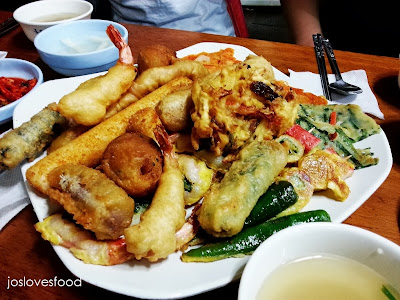Modern departmental stores are fancied by many people. It is convenient, chic, trendy to shop in the air-conditional place. The truth is traditional markets are an essential part of Korea. Many locals and even expatriates still visit the traditional markets. For travellers to truly immerse and appreciate a foreign country's culture, take some time to visit such history too. Many may have already heard of Namdaemun Market and Dongdaemun Market, let's try exploring 3 other traditional markets - Kwangjang Market, Gongdeok Market and Yeongdeungpo Market.
Kwangjang Market (광장시장) is said to be the nation's first traditional market, established in 1905. The 2-storey building is huge and has multiple sections including silk, clothes, beddings, handicrafts, shoes, agricultural, marine, household and of course cooked food. Impossible it may sound, there are approximately 5,000 shops under the roof of Kwangjang Market.
In this traditional markets that I have visited, almost all would have grocery shops selling traditional sweets and rice cakes. During autumn season, rice cakes are of abundance and are made using freshly harvested fruits and vegetables.
Never underestimate the food quality at the traditional markets. The food are fresh, delicious and likely to be cheaper compared to what you would pay for in restaurants at the popular tourist spots in Gangnam, Hongdae or even Myeongdong.
Two dishes that are highly popular in the Kwangjang market are the bindaetteok (빈대떡), Korean-style pancake made using grounded mung bean, green onions and mung bean sprouts. There is no meat in the pancake and it was known as the "poor man's pancake" because only the rich can afford to eat meat. But now, it has become a popular snack in the markets that a few stalls occupy the centre section in the market, taking centre-stage.
(grinding of mung bean)
(Pan-fried bindaetteok)
Another popular snack in the Kwangjang Market is Kimbap (김밥). These are small rice handrolls filled with carrots and picked daikon radish. The owner is over 80 years old and isn't shy to admit that her kimbap is most delicious. In fact, the kimbap were so delicious that it was openly known as mayak kimbap (마약김밥), literally means "drugged kimbap", It may sound misleading but the kimbap isn't drugged. It was meant that the kimbap are so delicious that once you tried it, you will crave for more.
(Mayak Kimbap)
Another traditional market, Gongdeok Market (공덕시장) is an unassuming place that is famous for pork trotters and Korean fried snacks. It is known as the Gongdeok-dong Jeon (means pancake) Alley. Not being a fan of pork trotters, I had tried the Korean fried snacks, which has a huge variety that it is quite a pain to decide what you should pick.
The fried snacks includes a spread of vegetables and mainly seafood. The items could be individually priced and it could be by weight. For this huge serving for 4 persons, plus side dishes, rice and makgeolli, it costs under USD25. Quite kind to the pocket and it is a great hub for food.
Crossing over now to the other side of the Han River, Yeongdeungpo Central Market is yet another huge market that is situated in the administrative district in Southwest Seoul, where the National Assembly, skyscraper 63 Building and trendy shopping mall Times Square are also located.
The market was established after the postwar period and had been the central place to distribute goods in the district including food, clothings, industrial, live produce etc. There are 600 over merchants and shops found in the market.
(wholesaler for cooking oil)
What particularly struck me along the food alley was the number of stalls selling sundae (순대), a dish made by steaming or boiling pigs' or cows' intestines and stuffed into blood sausages together with other ingredients such as cellaphone noodles, barley, rice, kimchi etc. The sausages are then cooked into soup or deep-fried.
Although the boiling pots of soup looking appetising, eating intestines is not something that I fancy. Perhaps I may buck up my courage to try if I attempt a few more trips to Korea and learn to appreciate the dish better. But if any of my adventurous readers are courageous enough to try, do let me know if it tastes good!
================================
Address: 6-1 Yeju-dong, Jungno-gu, Seoul
Operating Hours: 7am to 10pm (timing may vary from shop to shop)
By subway: 1) Jongno 5-ga Station (Line 1, Exit 8); 2) Euljiro 4-ga Station (Line 2 or 5, exit 4)
View Larger Map
Gongdeok Market (공덕시장)256-10 Gongdeok-dong, Mapo-gu, Seoul
By subway: Gongdeok Station, (A'REX, Line 5 or 6, Exit 5)
View Larger Map
Yeongdeungpo Market (영등포시장)
18 Yeongdeungpo 5-ga, Yeongdeungpo-gu, Seoul
By Subway, Yeongdeungpo-gu Office Station, (Line 5, exit 3), walk 25 m along the exit direction
View Larger Map
Related Posts
- Airfare Promotions to Seoul/Busan/Jeju (Click Here)
- Korean Food Culture: Korean Fried Chicken (Click Here)
- Gangwon-do: Chuncheon Dakgalbi (BBQ chicken) (Click Here)
- Guesthouse in Jeju: Minjunggak (Click Here)
- Getting to Jeju (Click Here)
Like my post? Follow me at Instagram (@joslovesfood), Facebook (Joslovesfood) and Twitter (@Joslovesfood)! ^^













No comments:
Post a Comment
All comments are welcomed